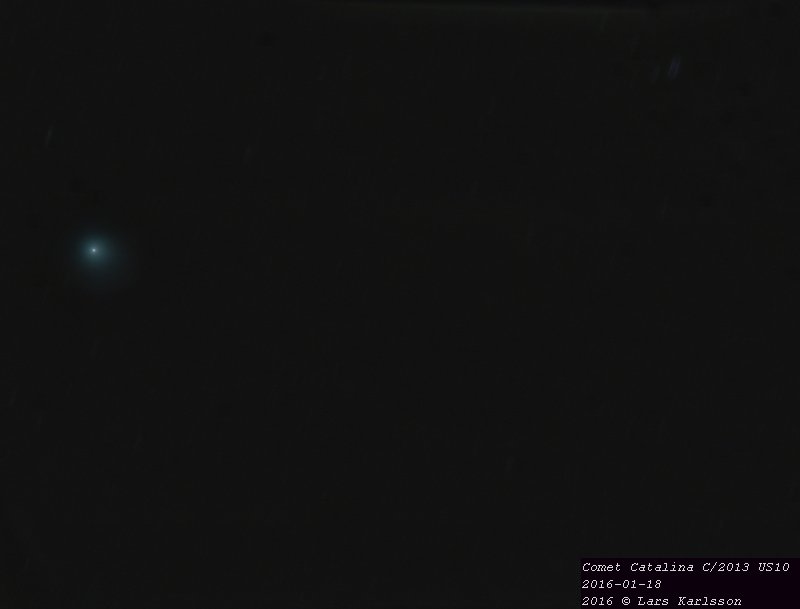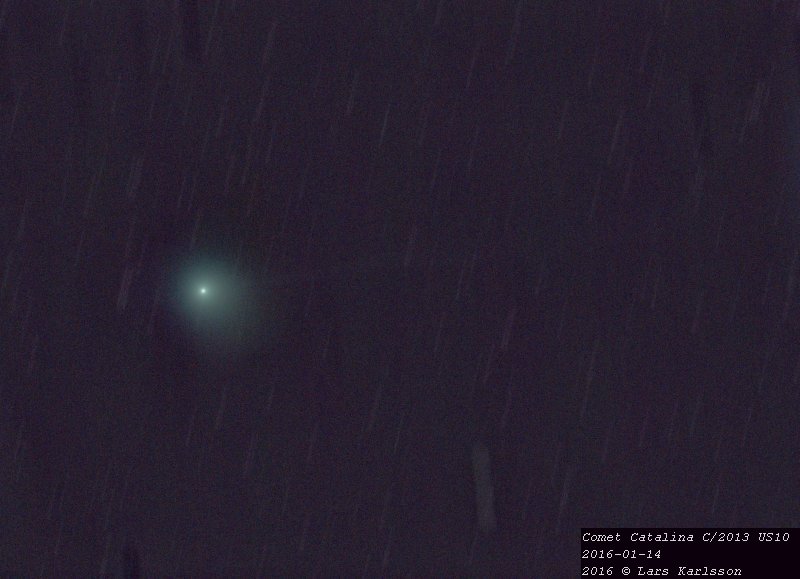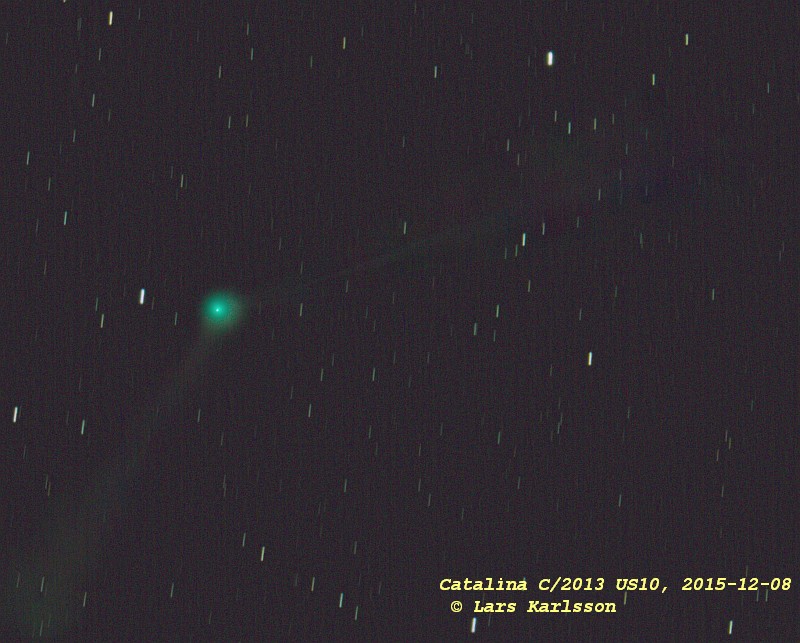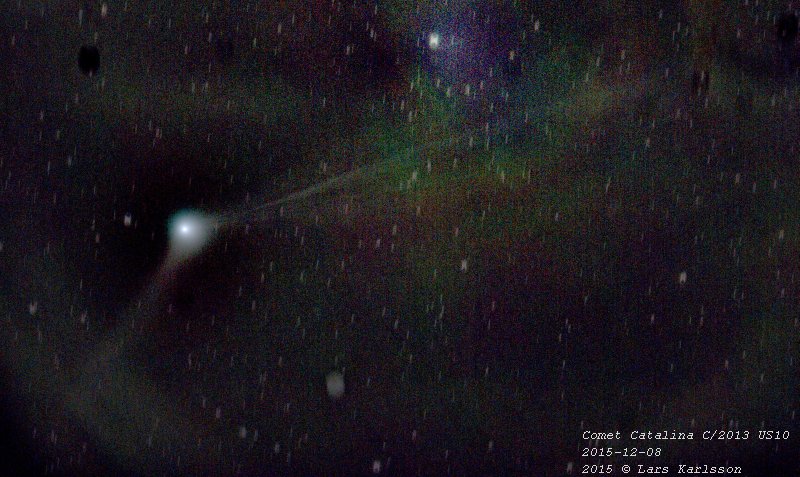|
Advertisement / Annons: |
Comet
|
| Object : | Comet, Catalina C/2013 US10 |
| Coordinates/Direction : | - |
| Object size : | - |
| Object magnitude : | - |
| More to know : |
You can read more about the comet on Seiichi Yoshida's homepage: http://www.aerith.net/ comet/ catalog/ 2013US10/ 2013US10.html |
Comet Catalina, 2016-01-18: |
| Date : | 2016-01-18 |
| Time (UT) : | 22:43 to 23:07 |
| Mount : | SkyWatcher EQ6 Pro, Belt drive, beltdrive modified (DIY 2019) |
| Guide : | QHY5 camera with off-axis |
| Lens/telescope : | TS130 APO f/7 910mm (682mm, f/5.2), 3" focuser |
| Corrector/Barlow : | Riccardi 2.5" field flatter, x0.75. T48 connector to camera |
| Field (FOV) : | 3.0 x 2.0o (full frame) before crop |
| camera : | Canon 6D, QE=0.5, full frame, 20 Mpixel, 14 bit |
| camera temperature: | About 6o C above surrounding temperature |
| Film/CCD : | Raw, Cr2 |
| Filter : | none |
| Control system : | Mount by EQMOD, camera by APT, guide by PHD2, focuser by USB-focus, ASCOM Windows PC |
| Exp. time : | 22x60 seconds, iso800, relative guided on a star |
| Image process tool : | Siril, Gimp, Irfanview |
| Processing : | align, resize, level, cal dark and gamma image processing |
| Site : | Sweden, Stockholm, Hagsätra.
Bortle 9 Free view Az: 20o to 90o, 165o to 185o, Alt: 20o to 55o |
| Comment : | The night after I took the last photos of the comet.
Very weak now, if I had been at a dark place I could got good quality photos even now. The temperature all these nights were from -5 to +6 degrees Celsius. Good for the camera, the noise get lower at low temperatures. |
Comet Catalina, 2016-01-17: |
| Date : | 2016-01-17 |
| Time (UT) : | 00:25 to 00:35 |
| Mount : | SkyWatcher EQ6 Pro, Belt drive, beltdrive modified (DIY 2019) |
| Guide : | QHY5 camera with off-axis |
| Lens/telescope : | TS130 APO f/7 910mm (682mm, f/5.2), 3" focuser |
| Corrector/Barlow : | Riccardi 2.5" field flatter, x0.75. T48 connector to camera |
| Field (FOV) : | 3.0 x 2.0o (full frame) before crop |
| camera : | Canon 6D, QE=0.5, full frame, 20 Mpixel, 14 bit |
| camera temperature: | About 6o C above surrounding temperature |
| Film/CCD : | Raw, Cr2 |
| Filter : | none |
| Control system : | Mount by EQMOD, camera by APT, guide by PHD2, focuser by USB-focus, ASCOM Windows PC |
| Exp. time : | 9x60 seconds, iso800, relative guided on a star |
| Image process tool : | Siril, Gimp, Irfanview |
| Processing : | align, resize, level, cal dark and gamma image processing |
| Site : | Sweden, Stockholm, Hagsätra.
Bortle 9 Free view Az: 20o to 90o, 165o to 185o, Alt: 20o to 55o |
| Comment : | Two days later after mid night it came openings in the clouds. I setup the equipment and hope I could some more photos. But the clouds come back and it was only 9 photos of bad quality I got. |
Comet Catalina, 2016-01-15: |
| Date : | 2016-01-15 |
| Time (UT) : | 00:11 to 00:57 |
| Mount : | SkyWatcher EQ6 Pro, Belt drive, beltdrive modified (DIY 2019) |
| Guide : | QHY5 camera with off-axis |
| Lens/telescope : | TS130 APO f/7 910mm (682mm, f/5.2), 3" focuser |
| Corrector/Barlow : | Riccardi 2.5" field flatter, x0.75. T48 connector to camera |
| Field (FOV) : | 3.0 x 2.0o (full frame) before crop |
| camera : | Canon 6D, QE=0.5, full frame, 20 Mpixel, 14 bit |
| camera temperature: | About 6o C above surrounding temperature |
| Film/CCD : | Raw, Cr2 |
| Filter : | none |
| Control system : | Mount by EQMOD, camera by APT, guide by PHD2, focuser by USB-focus, ASCOM Windows PC |
| Exp. time : | 38x60 seconds, iso800, relative guided on a star |
| Image process tool : | Siril, Gimp, Irfanview |
| Processing : | align, resize, level, cal dark and gamma image processing |
| Site : | Sweden, Stockholm, Hagsätra.
Bortle 9 Free view Az: 20o to 90o, 165o to 185o, Alt: 20o to 55o |
| Comment : | This night I could take one more set of photos, I increased the exposure time to 60 seconds. |
Comet Catalina, 2016-01-14: |
| Date : | 2016-01-14 |
| Time (UT) : | 23:05 to 23:49 |
| Mount : | SkyWatcher EQ6 Pro, Belt drive, beltdrive modified (DIY 2019) |
| Guide : | QHY5 camera with off-axis |
| Lens/telescope : | TS130 APO f/7 910mm (682mm, f/5.2), 3" focuser |
| Corrector/Barlow : | Riccardi 2.5" field flatter, x0.75. T48 connector to camera |
| Field (FOV) : | 3.0 x 2.0o (full frame) before crop |
| camera : | Canon 6D, QE=0.5, full frame, 20 Mpixel, 14 bit |
| camera temperature: | About 6o C above surrounding temperature |
| Film/CCD : | Raw, Cr2 |
| Filter : | none |
| Control system : | Mount by EQMOD, camera by APT, guide by PHD2, focuser by USB-focus, ASCOM Windows PC |
| Exp. time : | 60x30 seconds, iso800, relative guided on a star |
| Image process tool : | Siril, Gimp, Irfanview |
| Processing : | align, resize, level, cal dark and gamma image processing |
| Site : | Sweden, Stockholm, Hagsätra.
Bortle 9 Free view Az: 20o to 90o, 165o to 185o, Alt: 20o to 55o |
| Comment : | Over the Christmas it was bad weather and I had to wait to the next year in middle of January until I could take more photos. Now we are near the end of the maximum and the comet is getting weaker, still it's possible to see traces of the tail. |
Comet Catalina, 2016-01-14 + 2016-01-15: |
| Date : | 2016-01-14 + 2016-01-15 |
| Time (UT) : | - |
| Exp. time : | 60x30 + 38x60 seconds, iso800 |
| Site : | Sweden, Stockholm, Hagsätra.
Bortle 9 Free view Az: 20o to 90o, 165o to 185o, Alt: 20o to 55o |
| Comment : | I added two set of images together to reduce the noise and then increase the contrast. The right going tail is the plasma tail and the down going is the dust tail. At this moment the comet pass by the star in the handle of Great bear. |
Comet Catalina, 2015-12-14: |
| Date : | 2015-12-14 |
| Time (UT) : | 03:47 to 04:24 |
| Mount : | SkyWatcher EQ6 Pro, Belt drive, beltdrive modified (DIY 2019) |
| Guide : | QHY5 camera with off-axis |
| Lens/telescope : | TS130 APO f/7 910mm (682mm, f/5.2), 3" focuser |
| Corrector/Barlow : | Riccardi 2.5" field flatter, x0.75. T48 connector to camera |
| Field (FOV) : | 3.0 x 2.0o (full frame) before crop |
| camera : | Canon 6D, QE=0.5, full frame, 20 Mpixel, 14 bit |
| camera temperature: | About 6o C above surrounding temperature |
| Film/CCD : | Raw, Cr2 |
| Filter : | none |
| Control system : | Mount by EQMOD, camera by APT, guide by PHD2, focuser by USB-focus, ASCOM Windows PC |
| Exp. time : | 52x30 seconds, iso800, relative guided on a star |
| Image process tool : | Siril, Gimp, Irfanview |
| Processing : | align, resize, level, cal dark and gamma image processing |
| Site : | Sweden, Stockholm, Hagsätra.
Bortle 9 Free view Az: 20o to 90o, 165o to 185o, Alt: 20o to 55o |
| Comment : | One week later we had a clear sky again. Now it's closer to the comets maximal brightness, still it's weaker. I don't remember what cause it, probably the atmosphere. |
Comet Catalina, 2015-12-08: |
| Date : | 2015-12-08 |
| Time (UT) : | 03:59 to 04:38 |
| Mount : | SkyWatcher EQ6 Pro, Belt drive, beltdrive modified (DIY 2019) |
| Guide : | QHY5 camera with off-axis |
| Lens/telescope : | TS130 APO f/7 910mm (682mm, f/5.2), 3" focuser |
| Corrector/Barlow : | Riccardi 2.5" field flatter, x0.75. T48 connector to camera |
| Field (FOV) : | 3.0 x 2.0o (full frame) before crop |
| camera : | Canon 6D, QE=0.5, full frame, 20 Mpixel, 14 bit |
| camera temperature: | About 6o C above surrounding temperature |
| Film/CCD : | Raw, Cr2 |
| Filter : | none |
| Control system : | Mount by EQMOD, camera by APT, guide by PHD2, focuser by USB-focus, ASCOM Windows PC |
| Exp. time : | 48x30 seconds, iso800, relative guided on a star |
| Image process tool : | Fitswork, Irfanview |
| Processing : | align, resize, level, cal dark and gamma image processing |
| Site : | Sweden, Stockholm, Hagsätra.
Bortle 9 Free view Az: 20o to 90o, 165o to 185o, Alt: 20o to 55o |
| Comment : | Comet discovered 2013. A test with off-axis indirect auto guiding on stars and still follow moving objects like comets. When this photo was taken the comet was only 10 degrees over the horizon, it will be better in the middle of January. But that doesn't help, its peak at 6 magnitude is now in December. |
Comet Catalina, 2015-12-08: |
| Date : | 2015-12-08 |
| Time (UT) : | 03:59 to 04:38 |
| Image process tool : | Siril, Gimp, Irfanview |
| Processing : | align, resize, level, cal dark and gamma image processing |
| Comment : | Same photo but processed with more modern tools, push the contrast to the limit to make the tail more visible. The high contrast also make all defects visible, optics, dust blobs |
|
| Go Back |